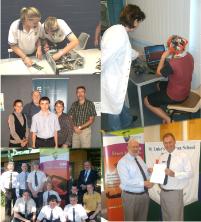Bundy proud of school engagement strategies
Published on 21 January, 2010
CQUniversity Bundaberg is becoming a leader for school engagement projects, complementing initiatives aimed at distance education and adult entry, according to Head of Campus Professor Phillip Clift...
Professor Clift acknowledges there will always be leakage due to the 'big smoke' factor, since there are more opportunities for part-time work and often a wider program choice in capital cities.

Recent school engagement initiatives
However, he says Bundaberg Campus is working towards a wider program selection while also addressing another key factor in attracting school leavers.
"The other main factor is the low rates of participation in tertiary education in the regional areas," Professor Clift says.
"A large component of all our new students are the first in their family to attend university. School engagement strategies will help to break down psychological barriers to school leaver participation and provide incentives for school leavers to join our programs."
More than 360 primary and high school girls converged on CQUniversity Bundaberg for a ‘Girls in the MIST' event in October last year. Thirty workshops were held for the students across the Maths, ICT, Science and Technology (MIST) areas. Dr Rose-Marie Thrupp and the Girls in the MIST project team gained a Highly Commended award in Queensland's Our Women, Our State Awards announced late last year.
Professor Clift said the CQUni Experience was piloted in Bundaberg 2 years ago as the Tertiary Awareness Program (TAP), with Year 10 students from Bundaberg State High School.
"It has now morphed into an Outreach, Access and Support Program funded by the Higher Education Equity Support Program (DEEWR) with many regional schools involved. Three schools from the Bundaberg region participated this year. Students visit the campus for a series of seminars and activities associated with university study. The aim is to enhance tertiary education participation rates even though students may choose to go to another university. Early indications are that the program is having a positive effect."
School linkages and the SUN (Start Uni Now) program are also proving worthwhile.
"The first course in the Bachelor of Aviation degree was taught at St Luke's Anglican School last year. All school students in the region were invited to attend St Luke's for classes on a Friday afternoon. (The lecturer undertook this as a voluntary contribution). This exercise was so successful that we have an MOU with St Luke's to implement the whole SUN program as a formal part of their curriculum," Professor Clift said.
"Preparatory work has been undertaken to offer a first-year Engineering course at Bundaberg State High School this year. Again, all school students in the region will be able to attend these sessions which will be held at the school. This project will be a valuable precursor to offering the common first 2 years of the Bachelor of Engineering degree at the Bundaberg Campus. It is also a useful adjunct to the development of the jointly sponsored Secondary School Engineering Trade Training Centre to be constructed in Bundaberg.
"Initial discussions are underway to offer a first-year Nursing course for students at Kepnock State High School on campus next year."
Professor Clift said secondary school principals in the Bundaberg region recognise the value of symbiotic relationships with the University and the SUN program is proving to be an ideal vehicle for the implementation of this strategy.
He said campus recognition of academic excellence in schools was ongoing and valuable, while the GetSet Program had been initiated as a pilot on Bundaberg Campus.
"GetSet was developed unashamedly to improve our enrolments in Business and IT but also to enhance school engagement and linkages with business.
"We believe the appeal of the program was that it provided an opportunity to relieve skill shortages in particular professional areas whilst ensuring opportunities for employment for senior school students who would study with us.
"The project has 4 main stakeholders - senior secondary school students and their parents; the schools; employers and the University. There is considerable flexibility in the way the student and employer approach the relationship."

